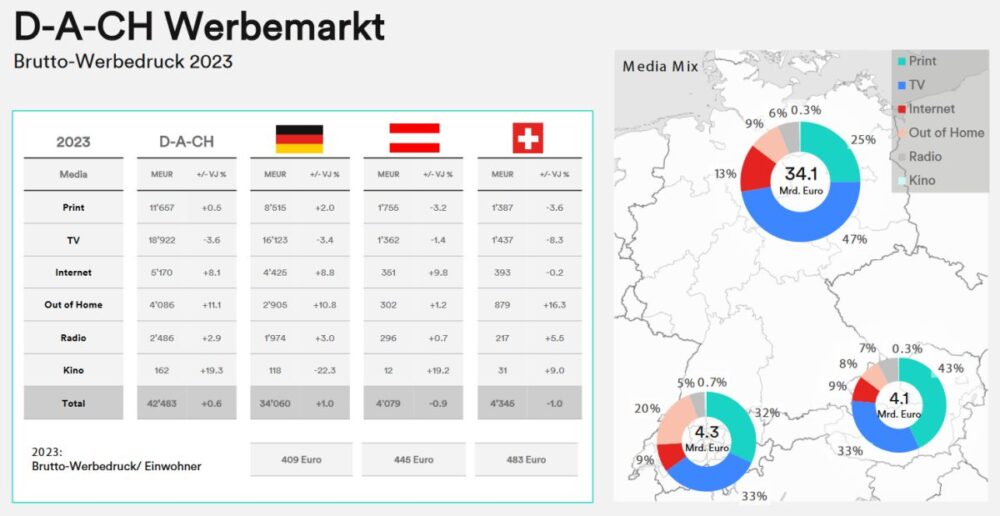Alcohol advertising spend to grow faster than the market in 2021
According to the "Zenith Business Intelligence - Alcohol: Beer + Spirits" report, alcohol advertising spend will grow by 5.3 percent this year, outpacing the overall advertising market (4.9 percent). Brands are recovering in this way from a much sharper decline in 2020. In 2022 and 2023, alcohol advertising will then grow roughly in line with the overall market, namely around 4-5 percent annually.
"In this country, we see a similar picture," explains Maria Brinkmann, Managing Director of Zenith in Switzerland. "Alcohol suppliers will increase their advertising investments by 8.0 percent to CHF 42 million in 2021. In subsequent years, they will increase their budgets by a further 7.1 percent (2022) and 1.5 percent (2023), so that the 2019 level will still be exceeded."
Pandemic shifts brand experience to the digital world
Alcohol brands are often not allowed to directly promote additional consumption. In any case, alcohol consumption is deeply rooted in the culture of the respective country and is not subject to rapid change. Instead, according to Zenith, brands have grown through a process of "premiumization": getting consumers to drink better, rather than more. In this, spirits brands have been more successful than beer brands. Consumption of beer and spirits remained essentially static between 2016 and 2019, according to Euromonitor International. But beer sales grew by three percent per year, while spirits sales grew by seven percent.
Premiumization means persuading consumers to switch to higher-value products by building brand image and experience through high-volume communications. Alcohol brands therefore rely heavily on television and outdoor advertising, spending twice as much on television as the average brand and nearly four times as much on outdoor advertising. Alcohol brands spent 49 percent of their budgets on television last year, compared to 24 percent for the average brand, and 19 percent on out-of-home advertising, compared to 5 percent. However, these tactics have become less effective as audiences shift to digital media, particularly young consumers who are most likely to visit a new bar and try a new drink.
"In Switzerland, the TV share looks somewhat different because of legislation on alcohol advertising," Brinkmann says. "Spirits in particular have strict regulations, and the Swiss advertising windows of the French private stations are subject to French advertising law, which is even stricter than Swiss advertising law. Accordingly, the TV share for alcohol advertising in Switzerland is currently only around 40 percent," Brinkmann elaborates.
More budget for digital
Alcohol brands have been slow to embrace digital advertising in the past, spending less than half their budget on it compared to the average for other brands in 2020. That's changing rapidly now. Restaurant closures meant brands needed a new way to market. Breweries, distilleries, bars and restaurants diversified into direct-to-consumer and takeaway drinks, facilitated by e-commerce and heavily promoted via digital media, especially social media.
Alcohol brands increased their digital media spending from 21 percent of budgets in 2019 to 24 percent in 2020. In an effort to create compelling brand experiences at home rather than at the bar, beverage companies invested in proprietary assets such as brand websites and educational content. Spirits brands that use influencers and retail partners to teach consumers how to mix their own cocktails, for example, were particularly noticeable.
"Spirits brands have overtaken beer brands in terms of sales value by offering more premium experiences and rituals around their product and service," said Ben Lukawski, global chief strategy officer at Zenith. "During the pandemic months' tap ban, brands have worked to bring their premium experiences home to consumers through their own digital content."
Consumers have embraced the available options for buying alcohol online, and alcohol brands now have good distribution networks in place to meet demand. Zenith expects brands to expand their digital advertising to support alcohol e-commerce even after pubs and restaurants have fully reopened. This will result in 9.2 percent annual growth in digital ad spend between 2019 and 2023, until digital advertising accounts for 30 percent of alcohol advertising budgets.
In addition, Zenith forecasts that alcohol brands will reduce their TV spending by 2.4 percent per year through 2023, compared to a 2019 baseline, as traditional TV audiences continue to shrink. Outdoor advertising, on the other hand, will grow 1.1 percent per year, even after accounting for pandemic-related declines in foot and road traffic. The declining reach of television makes the ubiquity of out-of-home even more valuable.
"In Switzerland, nearly 21 percent of alcohol brands' advertising dollars will flow into digital advertising in 2021," says Maria Brinkmann. "That's 9 percent more than in 2019. In 2022 and 2023, investment in online advertising by alcohol brands will continue to rise annually - to 23 percent next year and 25 percent the year after. This will be mainly at the expense of print."
Alcohol advertising recovers by 2023
Alcohol advertising shrank almost twice as fast as the overall advertising market in 2020, by 11.6 percent compared to 6.4 percent of the total market. Brands' finances were hit by declines in consumption volume, average price per drink and profit margins. As bars, pubs and restaurants closed, consumers drank less alcohol and bought the drinks they did consume from stores where they cost less, at a much lower markup. Brands cut back sharply on their marketing to protect their profits. Their combined advertising spend fell from $7.6 billion in 2019









